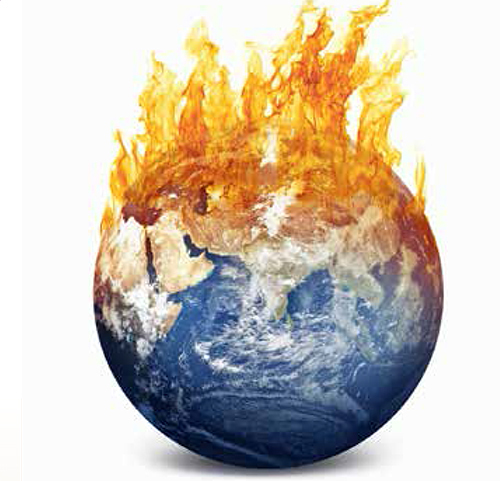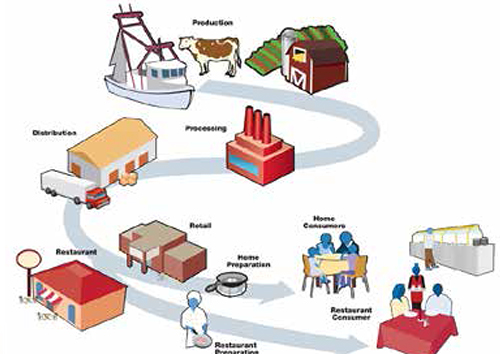Dr Jeff Obbard: Keeping our Stomachs Full in a Warming World

Food production is fundamentally linked to predictable seasonal weather patterns, which in turn, are the expression of stable climatic systems around the world. These systems are now shifting – thanks to the unrelenting emission of greenhouse gases and the gradual warming of our atmosphere. Fossil fuel combustion coupled to major disturbances of the world’s natural carbon sinks (forests, wetland, and peatlands) is now threatening global food security – just when there are more mouths to feed on the planet than ever before.
In its latest report, the Intergovernmental Panel on Climate Change (IPCC) concluded that global warming is now “unequivocal” and that the role of humanity is “clear”.
 One of the key goals of the United Nations Framework Convention on Climate Change (UNFCCC) way back in 1992 was “to ensure that food production is not threatened”, and to achieve “a time-frame sufficient to allow ecosystems to adapt naturally to climate change”. In hindsight, this has proven wishful thinking as the global agricultural system is increasingly exposed to warmer temperatures, rising sea levels, shifting rainfall patterns, desertification, and wildfires. According to the IPCC, global food production accounts for about 10% of global carbon emissions.
One of the key goals of the United Nations Framework Convention on Climate Change (UNFCCC) way back in 1992 was “to ensure that food production is not threatened”, and to achieve “a time-frame sufficient to allow ecosystems to adapt naturally to climate change”. In hindsight, this has proven wishful thinking as the global agricultural system is increasingly exposed to warmer temperatures, rising sea levels, shifting rainfall patterns, desertification, and wildfires. According to the IPCC, global food production accounts for about 10% of global carbon emissions.
As I write, the United Nations World Meteorological Organization (WMO) has reported that global atmospheric carbon dioxide levels for 2016 reached 403.3 ppm, now 45% higher than pre-industrial levels and rising at an accelerating rate. Based on best IPCC projections, wheat, rice, and maize production in tropical and temperate regions will be negatively impacted by global warming at local temperature increases of 2°C or more.
Impacts will vary between crops and regions, but a ‘business as usual’ predicted a global temperature increase of 4°C, combined with increasing food demand, will pose major risks to regional food security. Sustained crop production depends on predictable temperatures and rainfall patterns throughout the growing season – both of which are now distorted by global warming. A warmer climate increases the risk of drought and crop failure via heat stress and soil moisture loss. Paradoxically, a more energetic atmosphere means that rainfalls more intensely, increasing the risk of floods and soil erosion.
 A warmer atmosphere also encourages the proliferation of insect pests that quickly threaten vulnerable crops. Warmer oceans increase the risk of violent storms, hurricanes, and cyclones that can devastate crops, either directly from wind damage or indirectly via storm surges, inundation and the flooding of coastal farmlands. The loss of fertile agricultural soil is also exacerbated by poor farming practices and the over-intensification of agriculture.
A warmer atmosphere also encourages the proliferation of insect pests that quickly threaten vulnerable crops. Warmer oceans increase the risk of violent storms, hurricanes, and cyclones that can devastate crops, either directly from wind damage or indirectly via storm surges, inundation and the flooding of coastal farmlands. The loss of fertile agricultural soil is also exacerbated by poor farming practices and the over-intensification of agriculture.
However, a warming planet is not all bad news for global food production. Plants tend to grow faster at slightly warmer temperatures, meaning that land which is now ‘off-limits’ to farming in colder northern regions and higher altitudes becomes available for growing crops. However, this benefit is predicted to be short-lived as the world inexorably warms and temperatures exceed the tolerance threshold of staple food crops such as wheat, maize, and rice. Plants, just like us, are sensitive to rising temperatures. There is a delicate balance between vegetation’s ability to soak up carbon dioxide from the air, and releasing it back again. If things get too warm, a crop, a forest or even a wetland switches from being a sink of carbon dioxide to become a source.
Land clearing of carbon-rich forests and peatlands in Southeast Asia for agriculture can also lead to massive amounts of carbon being emitted into the atmosphere, further exacerbating global warming. The need to strike the right ecological balance in our food production system is something that modern agriculture recognizes and is now striving for.
Increasing harvests whilst conserving precious resources requires modern science and technology, as well as conventional agrarian wisdom. For example, it is now possible to genetically engineer crops such as maize, wheat, and rice to be more tolerant of heat stress and drought. This, combined with farming practices that reduce soil erosion and boost fertility, means food production can be sustained moving forward – at least for a while. Cutting carbon emissions from the global food supply chain stretches well beyond the farm. Harvesting, storage, and transportation of food generate massive emissions of carbon, as does food wastage and disposal. The luxury of having strawberries on the supermarket shelf out of season comes with a big carbon footprint when it means flying them halfway around the world. Fortunately, there is a spectrum of possibilities for reducing the carbon footprint of what we eat – from encouraging the local production (and consumption) of food, to reducing food wastage by simply consuming less, or using waste food to generate energy and soil compost.
Growing wealth and rise of the middle classes in rapidly growing economies such as China and Brazil has become synonymous with growing levels of red meat consumption, a much more energy and resource-intensive type of food compared to cereal crops. Science is coming to the rescue here too – think of farting cows and their emissions of the potent greenhouse gas methane! Engineered dietary supplements can significantly reduce methane emissions from livestock, so making the food chain a little more sustainable and climate-friendly. Although dietary preferences are deeply linked to religion, culture and personal values, simply by moderating our consumption of meat we can significantly reduce our carbon footprint, and also boost our health and well-being. Already, the threat of climate change to our food security is clear, at only a 1o C increase in average global surface temperatures. As global warming approaches (and likely exceeds) 2°C, then the risk of crossing thresholds and non-linear tipping points in the Earth’s climate system increases.
A new study published in the Lancet medical journal notes that reliable access to sufficient, affordable, and nutritious food can be negatively affected by climate change in many ways. This ranges from the direct impact of drought, flood, and heat on harvest yields, through to the health and social impacts of climate change, resulting in unhealthy populations unable to farm or work enough to earn money to purchase food. Furthermore, food trade could be disrupted as a result of damage to infrastructure caused by climate shocks. The IPCC has specifically identified food security as one of the key climate challenges facing Southeast Asia. As population and living standards continue to grow in our part of the world, the nexus between water, food, and energy security becomes ever more critical. It is Asia’s traditional knowledge of sustainable land cultivation, combined with modern scientific innovation and a more sustainable pattern of food consumption that offer sour best hope to safeguard food security and human well being into the 21st century.
A column by Professor Jeff Obbard, PhD
Related Posts
-
 FACE TO FACE: Prof Dr JEFF OBBARD No Comments | May 17, 2018
FACE TO FACE: Prof Dr JEFF OBBARD No Comments | May 17, 2018 -
 Workshops Gallery No Comments | Nov 20, 2017
Workshops Gallery No Comments | Nov 20, 2017 -
 Living Planet,Singapore No Comments | Aug 27, 2019
Living Planet,Singapore No Comments | Aug 27, 2019 -
 Climate Change Workshop No Comments | Apr 11, 2018
Climate Change Workshop No Comments | Apr 11, 2018


